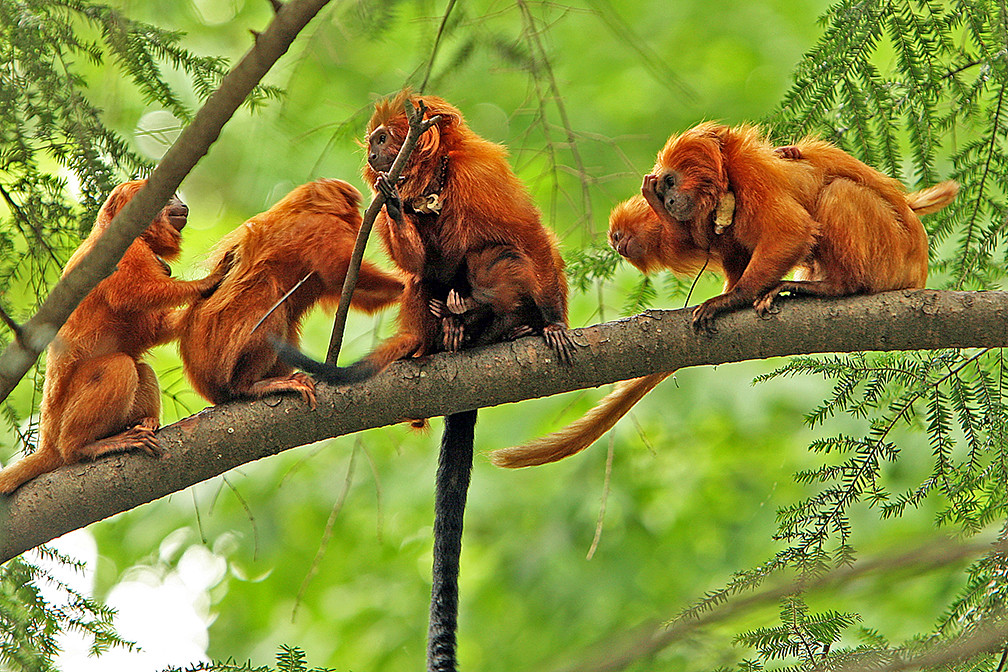It is not just people who are suffering from a viral outbreak right now. So are endangered golden lion tamarins, whose survival is at stake. The culprit is yellow fever, a mosquito-borne disease which first appeared among the primates in Brazil two years ago.
Conservationists are racing against time to provide them with a vaccine, but another outbreak has been slowing down those efforts: Covid-19.
As their name suggests, the small primates, which are endemic to Brazil’s Atlantic Forest, bear a passing resemblance with their orangey manes to African male lions. Also called marmosets, the New World monkeys grow only to 22 centimeters (without their lengthy tails) and weigh a mere 800 grams.
Because of their diminutive size and distinctive looks, which many people find adorable, they have become popular as exotic pets, which poses another threat to their survival in the wild. Golden lion tamarins, which are classified as endangered animal by the International Union for Conservation of Nature (IUCN), were almost driven into extinction by a combination of threats such as habitat loss and poaching for the exotic pet trade.
Faced by these threats, the population of tamarins in the wild plunged to a mere few hundred in the 1960s and 1970s, causing them to be listed as critically endangered. However, the species has managed to bounce back thanks to concerted conservation efforts, including captive-breeding programs for releasing marmosets back into their natural habitats.
As part of targeted conservation initiatives a number of the primates have been relocated from fragmented habitats into larger and undisturbed forests. These efforts have succeeded in growing their numbers while also ensuring genetic diversity in wild populations so that by 2014 wild tamarins numbered about 3,700 individuals.
Then disaster struck. In late 2016 Brazil experienced a severe outbreak of yellow fever, which by 2018 began to sicken tamarins in what came as a surprise to conservationists. In fact, golden lion tamarins proved to be even more vulnerable to the disease than people are.
“[W]e didn’t know if the [animals] were susceptible to the disease, even after four decades of working with the tamarins, but we now understand that they are even more susceptible to it than humans,” explains Carlos Ramon Ruiz-Miranda, president of the Associação Mico-Leão-Dourado (the Golden Lion Tamarin Association).
The mosquito-born disease has caused the population of the monkeys to plummet by a third in just two years. Their survival now depends on whether they can acquire immunity to yellow fever either naturally or by help of a vaccine administered to them by people.
Conservationists have decided that inoculation was the safest option and a vaccine is now available for just that purpose. Yet vaccinating the small animals is easier said than done.
Individual golden lion tamarins can be located in a forest within a few days by a small research team equipped with radio transmitters, but a team with no such equipment can take up to two months to find them.
Once they are captured in a special trap, the primates are sedated so experts can perform a check-up on their health and administer the vaccine for yellow fever. At least several hundred tamarins need to be vaccinated to protect their populations against yellow fever.
However, the ongoing Covid-19 pandemic, to which governments have responded by severely restricting the movement of people, has been slowing things down with the vaccination process mired in red tape.
“We were very frustrated and irritated with the bureaucracy,” says Ruiz-Miranda. “We were making weekly calls to try to get something going with the vaccination and to have a quick response to the realization we had lost the tamarins.”
Time is of the essence in a race to save the tamarins from any further ravages of the disease within their ranks. “The smaller the population, the higher the probability that any small catastrophic event could wipe them out,” Ruiz-Miranda warns. “If nothing is done, we could start seeing local extinctions.”
Did you like it? 4.4/5 (21)








